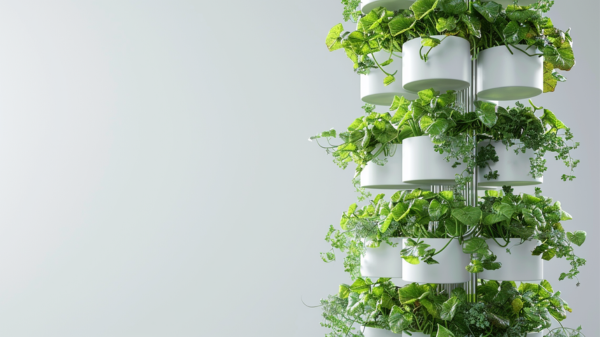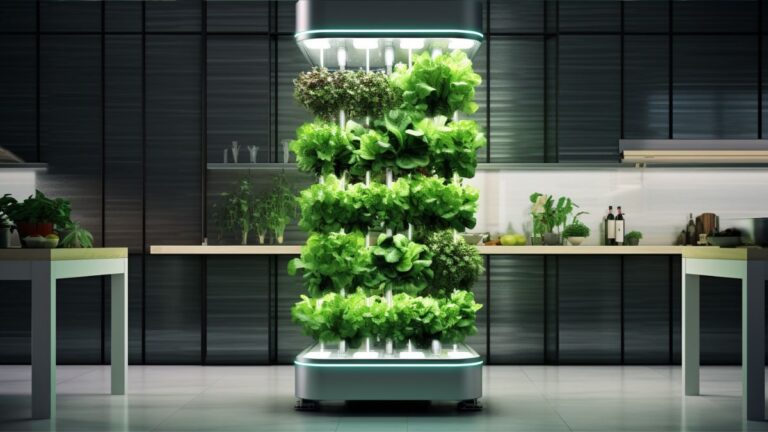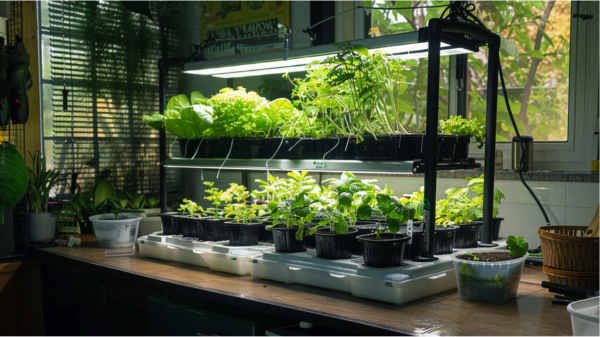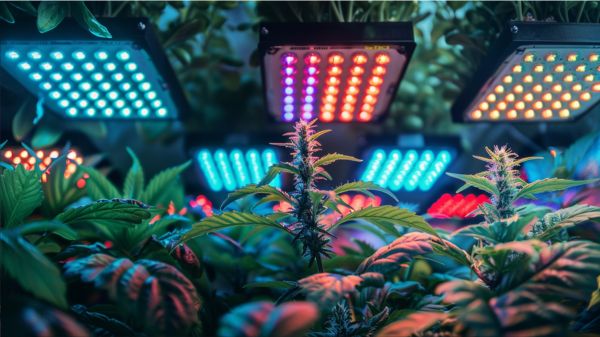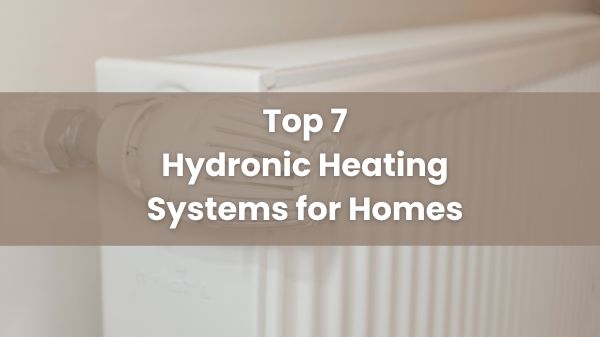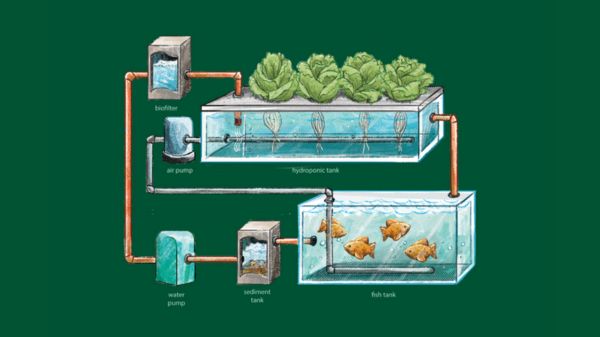Revolutionize Urban Agriculture with Vertical Hydroponic System
Vertical hydroponic system utilizes advanced vertical farming techniques to optimize crop yield in limited urban spaces. This system stacks plant layers, maximizing production efficiency. Challenges like lighting access and clogging are addressed through strategic design.
Components like submersible pumps deliver nutrients efficiently to plant roots in compact spaces. Maintenance involves regular water level monitoring, pH balance checks, algae control, and nutrient solutions adjustments. These systems offer disease prevention benefits and year-round production capabilities. Discover more about the innovative world of vertical hydroponics for sustainable agriculture.
Key Takeaways
- Utilizes vertical space efficiently for high-density crop yield.
- Ideal for small areas like balconies, maximizing production.
- Requires regular monitoring for lighting access and clogging.
- Compact design with small nutrient reservoirs for minimal space.
- Suitable for growing produce with less water consumption.
Understanding Hydroponics
Utilizing a soil-less cultivation technique, hydroponics involves growing plants by supplying them with essential mineral nutrients dissolved in water. In a vertical hydroponic system, this method is taken to new heights—literally. Vertical hydroponic systems use vertical towers to grow plants, allowing for a high-density yield per unit area. These systems are ideal for small spaces like balconies or rooftops, where traditional gardening may not be feasible.
The beauty of vertical hydroponics lies in its efficient use of water and nutrients. With over 90% efficiency in water utilization, these systems offer year-round production indoors, making them a sustainable choice for urban farming. Moreover, by eliminating soil from the equation, vertical hydroponics reduce the risk of soil-borne diseases, which is particularly advantageous in crowded urban areas.
Whether purchasing a pre-made vertical hydroponic tower or opting to build one, these systems can accommodate various crops ranging from strawberries and lettuce to herbs. The versatility and productivity of vertical hydroponic systems have made them a popular choice for modern farming practices.
The Rise of Vertical Farming
Incorporating cutting-edge agricultural methods, the phenomenon of vertical farming has rapidly ascended as a sustainable solution for maximizing crop production in limited spaces. Vertical farming involves cultivating crops in vertically stacked layers, often utilizing hydroponic systems that deliver water and nutrients directly to plant roots. This innovative approach minimizes land use while maximizing output, making it ideal for urban settings where space is scarce.
One of the key components of vertical farming is the efficient water system, which recycles and circulates nutrient-rich water to nourish plants, reducing water wastage compared to traditional farming methods. Additionally, the controlled environment of vertical farming allows for year-round cultivation, independent of external weather conditions.
To optimize plant growth, vertical farming systems integrate advanced technologies such as specialized grow lights to mimic natural sunlight and automated nutrient delivery systems. Tower systems, a common vertical farming setup, enable the cultivation of a wide variety of crops in a compact footprint. Vertical farming represents a promising future for sustainable agriculture, addressing the challenges of food security and environmental sustainability with ingenuity and efficiency.
Types of Vertical Systems
Vertical hydroponic systems encompass a variety of designs that efficiently utilize vertical space for crop cultivation. One common type is the Vertical Tower System, which offers compact space requirements and high efficiency in crop production. These systems often incorporate a water system with a submersible pump to deliver nutrients to the plants efficiently.
Another popular design is the Stacked Hydroponic System, known for its effective use of vertical space. Stacked systems may utilize wheels or lazy Susans for easy rotation, optimizing space and ensuring effective crop growth. Despite their benefits, challenges such as lighting access and clogging may arise with vertical systems. Additionally, these systems typically have smaller nutrient reservoirs compared to horizontal setups, requiring more frequent monitoring and maintenance.
However, vertical hydroponic systems remain an excellent choice for those looking to grow fresh produce using less water and minimal space.
Key Components Required
Crucial elements essential for the functionality of a vertical hydroponic system include a submersible pump, water circulation tubing, and designated structures for plant placement.
The submersible pump is the powerhouse of the system, responsible for pumping nutrient-rich water through the tubes to the top of the vertical structure. This water then cascades down, providing a constant flow of nutrients to the plants arranged in trays or towers. The plant roots, typically housed in net cups filled with stone wool or grow cubes, absorb these nutrients, promoting healthy growth.
The vertical arrangement of plants maximizes space efficiency, allowing for more crops to be grown in a smaller area. To assure optimal plant development, the pump in the system operates continuously, with the option of additional aeration for enhanced oxygen supply.
These key components collectively create a compact and efficient hydroponic system that is favored by both commercial growers and hobbyists for its productivity and resource efficiency.
Selecting the Right Location
When establishing a Vertical Hydroponic System, selecting a suitable location plays a critical role in ensuring ideal plant growth and system efficiency. For successful hydroponic growing, it is important to choose a spot that receives ample sunlight, ideally for 6-8 hours daily, to provide plants with the energy they need for photosynthesis. Additionally, confirm the chosen location is well-ventilated to prevent heat buildup and promote ideal plant growth.
Proximity to a water source is another essential factor to contemplate when deciding on the location for your vertical garden. Easy access to water will facilitate the refilling and maintenance of your hydroponic system, ensuring that your plants receive the necessary nutrients consistently. Additionally, opt for a stable surface to set up your vertical garden to prevent any tilting or instability that could potentially harm your plants or disrupt the system’s functionality.
Lastly, evaluate the space for protection against extreme weather conditions or potential damage to safeguard your hydroponic setup and promote a conducive environment for plant growth. By carefully contemplating these factors, you can set up your vertical hydroponic system for success.
Building Your Own Tower
To construct your own vertical hydroponic tower, gather necessary materials such as white vinyl fence posts, a 45-gallon tank, PVC pipes, and a submersible pump.
Start by assembling the PVC pipes vertically, guaranteeing a secure structure for your plants to grow. The PVC pipe will act as the backbone of your tower, allowing for the circulation of nutrient-rich water to reach all levels efficiently. Consider the water level in the tank to maintain proper hydration for your plants; a consistent water supply is crucial for peak growth.
When customizing your tower, focus on providing adequate support at the top to prevent any instability issues as your plants flourish. Ensure proper drainage to avoid waterlogging, which could harm your crops. Remember, a shield can be a great addition to prevent water splashing onto your delicate greens.
Embrace the vertical design of your hydroponic system to maximize space and promote high-density yields per unit area. With the right care and attention, your DIY vertical hydroponic tower will be a thriving ecosystem for various crops like strawberries, lettuce, and herbs.
Nurturing Your Garden
An essential aspect of maintaining a healthy and productive vertical hydroponic garden is implementing a consistent nutrient feeding schedule tailored to the specific needs of the plants being cultivated. In vertical hydroponic systems, plants are placed directly into nutrient-rich water solutions, which provide essential minerals and nutrients for their growth. It is vital to monitor and adjust the nutrient levels regularly to guarantee ideal plant development. Typically, plants in vertical hydroponic systems require around 20-30 gallons per square foot of growing area per year, depending on the plant species and growth stage.
The efficient use of floor space is a significant advantage of vertical hydroponic systems. By utilizing the vertical space, these systems can accommodate a large number of plants in a small footprint. This maximizes production while minimizing the physical area required. Additionally, vertical hydroponic systems eliminate the need for soil, which reduces the risk of soil-borne diseases and pests. This innovative method of gardening, also known as vertical farming, not only saves water but is also a sustainable solution for modern agriculture.
Water Management Essentials
Proper management of water is a critical element in ensuring ideal plant growth and nutrient absorption in a vertical hydroponic system. Monitoring water levels and pH balance regularly is essential to prevent nutrient imbalances that could harm plants.
Utilizing a submersible pump with the correct flow rate is indispensable for efficiently circulating water and nutrients throughout the system. Implementing a reservoir system helps store and supply water consistently to the plants, ensuring they have continuous access to necessary nutrients.
Additionally, maintaining cleanliness and controlling algae growth in the water reservoir is crucial to prevent contamination and safeguard plant health within the hydroponic system. By adhering to these water management essentials, you can create a well-balanced environment for your plants to thrive in a vertical hydroponic system.
Lighting for Growth
Water management is pivotal for plant health in a vertical hydroponic system, and establishing ideal lighting conditions is equally essential for maximizing growth and productivity.
LED grow lights have become the go-to choice for vertical hydroponic setups due to their energy efficiency and customizable features. These lights come in various designs and spectrums, allowing growers to cater to specific plant requirements.
Proper light quality and coverage are indispensable factors to ponder, as different plants have varying light needs for peak growth. In addition to promoting growth, LED grow lights are also utilized in greenhouse propagation techniques for ornamental plant production, showcasing their versatility in horticultural practices.
Effective lighting strategies not only enhance plant yield but also contribute to overall plant health in vertical hydroponic systems. By ensuring the right lighting conditions, growers can create an environment that fosters robust growth and flourishing crops in a vertical farming setup.
Related Post: Top 5 Energy-Efficient LED Lights for Hydroponics.
Nutrient Solutions 101
Nutrient solutions play a fundamental role in vertical hydroponic systems by providing essential minerals and elements necessary for robust plant growth. These solutions are meticulously crafted to cater to the specific requirements of different plant species, ensuring they receive the nutrients crucial for their development.
As plants progress through various growth stages, the nutrient solutions can be fine-tuned to optimize their overall health and productivity. Maintaining the proper pH levels within the solution is paramount as it directly influences the plants’ ability to absorb nutrients effectively.
Monitoring and regulating the quality of the nutrient solution is a critical task in vertical hydroponic systems to guarantee successful and flourishing plant growth. Remember, happy plants make for a happy grower! So, stay vigilant with your nutrient solutions, and your vertical garden will thrive with green goodness.
Plant Selection Tips
In vertical hydroponic systems, the choice of plant species is a critical factor influencing the efficiency and success of the cultivation setup. This choice is particularly focused on growth habits, size, and light requirements for peak performance. Best choices include leafy greens such as lettuce, compact herbs like basil, and petite fruits such as strawberries, as they effectively utilize the vertical space provided.
When selecting plants, it is advantageous to opt for varieties with similar nutrient and water needs to streamline maintenance in a vertical hydroponic environment. Plants with shallow root systems are highly recommended for these systems, promoting maximum growth and yield within the vertical constraints.
To enhance the aesthetics and functionality of your vertical garden, incorporating a diverse range of plant species is key. Remember, a well-thought-out selection of plants not only guarantees efficient use of space but also adds a visually appealing element to your vertical hydroponic system.
Related Post: Green Thumb Made Easy: 5 Best Hydroponic Plants for Beginners.
Pest and Disease Control
When addressing pest and disease control in vertical hydroponic systems, implementing integrated pest management strategies is essential for maintaining plant health and productivity.
Monitoring plants regularly for signs of pests and diseases is vital in a vertical hydroponic setup. Utilizing beneficial insects like ladybugs and predatory mites can help control pest populations naturally, reducing the need for chemical interventions.
Maintaining proper hygiene and cleanliness within the system is key to preventing the spread of diseases. Additionally, considering the use of organic pesticides or fungicides approved for hydroponic use can effectively address pest and disease issues while minimizing harm to the environment and human health.
Maximizing Space Efficiency
To optimize spatial utilization in vertical hydroponic systems, a strategic emphasis is placed on maximizing space efficiency through innovative design and cultivation techniques. Vertical hydroponic systems excel in utilizing vertical space for plant growth, allowing for the cultivation of more plants in a smaller footprint. By stacking plants vertically, these systems notably increase the yield per square foot of growing area.
The efficient use of space in vertical hydroponic systems enables higher plant density and enhanced production compared to traditional growing methods. This optimization of space not only provides a compact and effective way to grow various crops but also caters to the needs of urban gardeners or those with limited space. The versatility of vertical hydroponic systems in maximizing space efficiency makes them ideal for small spaces like balconies, indoor environments, or even unconventional locations such as basements or shipping containers.
Essentially, these systems offer a practical solution for maximizing plant growth in limited areas while maintaining sustainability and resource efficiency.
Harvesting Your Produce
The process of harvesting produce in a vertical hydroponic system involves the careful selection and extraction of ripe fruits and vegetables from the plants. Timing is vital as it guarantees the best flavor, texture, and nutritional value of the produce.
When harvesting, it is essential to gently remove the fruits and vegetables from the plants to prevent any damage that could impact future growth. Regularly monitoring plant health and growth is key to determining the readiness for harvest, making certain that you pick the fruits and vegetables at their peak.
The satisfaction of harvesting your own fresh, pesticide-free produce at home is unmatched. Remember, the joy of harvesting is not just in the fruits of your labor, but also in the knowledge that you are consuming healthy, home-grown produce.
Harvesting from your vertical hydroponic system can be a rewarding experience, offering a continuous supply of delicious and nutritious crops right at your fingertips.
System Maintenance
After successfully harvesting your produce, the next step in maintaining a Vertical Hydroponic System is to guarantee proper system maintenance to sustain peak plant health and growth. Regular maintenance tasks include cleaning the tower with bleach after each crop to prevent contamination, monitoring and adjusting pH and EC levels of the nutrient solution, ensuring proper water levels in the tank for hydration, and sealing joints to prevent water leakage.
Maintaining the pH and EC levels within the recommended range is vital for healthy plant development in the system. Remember, a happy plant is a growing plant, so keep those nutrient levels in check!
A well-maintained system not only ensures the health of your plants but also maximizes the efficiency of your vertical hydroponic setup. Stay on top of maintenance, and your vertical hydroponic system will be flourishing in no time!
Advantages of Vertical Hydroponics
Vertical hydroponics offer a significant advantage in maximizing space efficiency through high-density yield per unit area. By utilizing vertical space effectively, these systems allow for more plants to be grown in a smaller footprint compared to traditional horizontal setups. This efficiency is particularly beneficial for urban areas or locations with limited space, where maximizing production is crucial. Additionally, vertical hydroponic systems are ideal for small sunny places like balconies, patios, and rooftops, making them accessible to a wide range of growers.
Moreover, the year-round production capability of vertical hydroponics guarantees a continuous harvest regardless of external weather conditions. This feature is especially advantageous for regions with harsh winters or limited sunlight hours. Additionally, the elimination of soil in vertical hydroponic systems not only reduces the risk of soil-borne diseases but also promotes healthier plant growth by providing a controlled environment for root development. Overall, the combination of space efficiency, year-round production, and disease prevention makes vertical hydroponics a compelling choice for modern farming practices.
Overcoming Common Challenges
To address the challenges commonly encountered in vertical hydroponic systems, innovative solutions have been developed to enhance efficiency and productivity.
- Lighting Optimization: Implementing LED grow lights tailored to specific plant needs can guarantee proper growth and energy efficiency.
- Nutrient Management: Utilizing automated nutrient dosing systems helps maintain ideal nutrient levels, promoting healthy plant growth.
- Temperature Regulation: Installing climate control systems such as fans or heaters can stabilize temperatures, creating a perfect growing environment.
- Pest Control: Introducing beneficial insects or using organic pesticides can effectively manage pests without harming the plants or the environment.
- Water Quality Monitoring: Employing water quality sensors and filtration systems ensures that plants receive clean, well-balanced water, promoting the best growth.
Future of Vertical Farming
The evolution of vertical farming presents a sustainable and innovative solution to meeting the increasing demands for efficient agricultural practices in urban environments. Vertical farming is not just a trend; it is a necessity in our rapidly urbanizing world. With the ability to maximize space efficiency, reduce water consumption, and minimize pesticide use, vertical farming is a game-changer in the agricultural industry.
The future of vertical farming holds great promise. Advances in technology, such as automated systems and AI integration, are revolutionizing the way we grow crops. High-density vertical hydroponic systems like the ZipGrow Farm Wall are paving the way for year-round production of fresh produce. Additionally, the ability to cultivate crops in urban areas helps address food security challenges and reduces the environmental impact of traditional farming practices.
As we look ahead, vertical farming is poised to play a significant role in increasing agricultural productivity while promoting sustainability. The sky’s the limit for vertical farming – or should we say, the skyscraper’s the limit!
Case Studies and Success Stories
Several real-world examples showcase the transformative impact of vertical hydroponic systems in enhancing agricultural productivity and sustainability. Vertical hydroponic systems have proven to be a game-changer in modern farming practices, as seen in various successful case studies and inspiring success stories.
Here are some key bullet points that highlight the emotional and practical benefits of these innovative systems:
- A small urban farm in the heart of the city saw a 200% increase in crop yield after switching to a vertical hydroponic setup, bringing fresh produce to the local community and reducing food miles.
- A family-owned greenhouse business adopted vertical hydroponics and witnessed a 30% improvement in water efficiency, leading to cost savings and environmental conservation.
- An abandoned warehouse was transformed into a thriving vertical farm, demonstrating how underutilized spaces can be repurposed for sustainable agriculture while creating jobs in the community.
- A school project integrating vertical hydroponics not only educated students about modern farming techniques but also sparked a passion for environmental stewardship and healthy eating habits.
- A research facility’s adoption of vertical hydroponic systems led to groundbreaking discoveries in plant biology and sustainable food production, inspiring future innovations in agriculture.
Getting Involved in the Community
Exploring community engagement opportunities related to vertical hydroponic systems can provide valuable hands-on experience and networking opportunities for individuals interested in sustainable agriculture practices. Engaging with online forums and social media groups dedicated to vertical hydroponics allows for the exchange of knowledge and ideas with like-minded individuals. Attending local workshops, seminars, or community events focused on vertical hydroponics provides a platform to learn from experts and enthusiasts in the field.
Volunteering at community gardens or urban farming projects that utilize vertical hydroponic systems offers practical experience in setting up and maintaining these innovative farming systems. Joining local gardening clubs or associations that promote sustainable growing methods like vertical hydroponics can foster connections with fellow growers and enthusiasts.
Furthermore, collaborating with schools, universities, or research institutions involved in vertical hydroponic projects not only expands one’s knowledge but also contributes to the community’s understanding of these advanced farming techniques. By actively participating in community initiatives related to vertical hydroponic systems, individuals can make a meaningful impact while furthering their own expertise in sustainable agriculture practices.
Frequently Asked Questions
Is Vertical or Horizontal Hydroponic Farming Better?
Vertical hydroponic farming is superior due to its space efficiency, higher crop yield, and easier maintenance access. Horizontal systems lack scalability in urban areas and may not optimize space usage as effectively. Choose vertical for maximum productivity.
How Do Vertical Hydroponic Systems Work?
Vertical hydroponic systems work by circulating nutrient-rich water to plants in vertical towers or trays. Water is pumped to the top, flowing down to feed plants in net cups filled with grow medium. This method maximizes space and water efficiency.
What Are the 3 Main Disadvantages of Hydroponic Farming?
The main disadvantages of hydroponic farming include vulnerability to system failures, challenges in maintaining nutrient levels, and reliance on artificial lighting leading to increased energy costs. Initial setup expenses and the need for specialized knowledge are additional drawbacks.
What Is the Difference Between Vertical Hydroponics and Aeroponics?
Vertical hydroponics utilizes stacked systems for plant growth in a vertical space with nutrient water flowing down, while aeroponics mists plant roots with nutrient-rich solution. Both methods offer advantages in efficient water usage and space utilization, catering to different cultivation needs.
Conclusion
To sum up, the vertical hydroponic system presents a promising solution for maximizing space utilization and improving water efficiency in plant cultivation.
With its advanced techniques and adaptability to diverse settings, this method of farming has the potential to revolutionize agricultural practices.
By addressing common challenges and exploring future opportunities, vertical hydroponic systems offer a sustainable and efficient approach to modern farming that can benefit communities and the environment.
